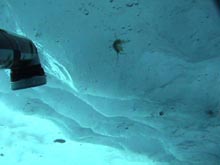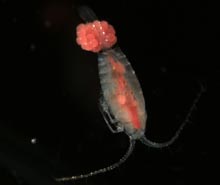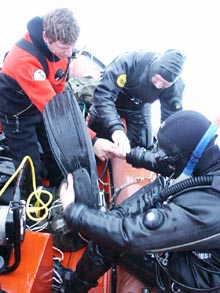
Under-ice scuba divers captured this image of the amphipod, Gammarus wilkitzkii, hiding just within the ice. (Photo by Rolf Gradinger, University of Alaska Fairbanks.) Click image for larger view.
Highlights of Life in the Crystal Palace of Sea Ice Communities
August 14 - September 8, 2002
Dr. Rolf Gradinger
University of Alaska, Fairbanks
In the Arctic, the summer sea ice has unique characteristics with respect to its temperature, salinity and porosity. A specialized community is adapted to the variable conditions of this ice environment and exists year-round. A unique, partially endemic fauna, mainly comprising several amphipod species, thrive permanently at the underside of the ice floes. Moving along the bottom of the ice, they feed on the ice bottom community and use larger brine channels and crevasses as shelter against predators. Studies on Arctic sea ice communities are an urgent issue, not only because of the small amount of published data, but also due to the observed and predicted substantial loss of ice over the last and coming decades. Sea ice might also be a model substrate for habitats found on extraterrestrial environments such as Europa or Mars.
No visible coloration of the sea ice by algae or sediment was detected at any location during the entire cruise. Melt ponds covered from 40% to 70% of the surface of the ice floes, although they were often partially refrozen. Thickness of the ice floes sampled by ice coring varied from 1.6 m to more than 4 m.

Scientists were surprised to find evidence of reproduction late in the Arctic summer. This copepod (Family Aetideidae), laden with eggs, was captured in a net tow by the Pelagic Ecological Group. (Photo by Russ Hopcroft, University of Alaska Fairbanks.) Click image for larger view.

Jeremy Stewart and Wayne Smith, divers from Canada's Department of Fisheries and Oceans, and a National Geographic photographer prepare to descend into icy Arctic waters. Click image for larger view.
Even though we encountered very little sea ice algae in the Canada Basin, we did identify the presence of larger fauna, such as turbellarians, nematodes and harpacticoid copepods. We found that the diversity of this life in the ice was low (only one species of each group was found). The total abundance of these animals was less than 100 individuals per liter of melted sea ice, and they were found only in the lowermost 15 cm of the ice floes. We were very surprised to find that several female copepods had egg sacs, indicating that they were reproducing during the late arctic summer rather than only in the spring. To our knowledge, this has never before been documented.
Under-ice amphipods caught by the divers belong to the species Apherusa glacialis, Onisimus spp. and Gammarus wilkitzkii. For A. glacialis and G. wilkitzkii, both adult animals and juveniles were present. One female G. wilkitzkii released a total of 32 juveniles from her marsupium within several days in a tank aboard the ship. Overall, the video from the eastern Canada Basin under-ice stations showed very low numbers of amphipods in the areas studied.
For more information regarding the Sea Ice Ecological Group and the scuba divers, see the September 3, August 30, August 26, and August 19 logs.
Sign up for the Ocean Explorer E-mail Update List.


























